The Lord of the Rings: A Personal Reading, Part Two
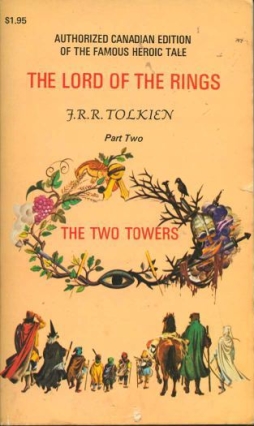 This is the second of three posts prompted by a recent re-reading of The Lord of the Rings. As I said in the first post, I went back to the book with the general idea of approaching it as one would a medieval saga, rather than a contemporary novel, and seeing what struck me as a result. I wrote in that post about what it seemed to suggest to me about Tolkien’s sense of character, and next week I intend to write about his use of irony — or, if you prefer, an anti-irony that shows how good can emerge out of apparent evil.
This is the second of three posts prompted by a recent re-reading of The Lord of the Rings. As I said in the first post, I went back to the book with the general idea of approaching it as one would a medieval saga, rather than a contemporary novel, and seeing what struck me as a result. I wrote in that post about what it seemed to suggest to me about Tolkien’s sense of character, and next week I intend to write about his use of irony — or, if you prefer, an anti-irony that shows how good can emerge out of apparent evil.
But this week I want to consider the aspect of the work which is perhaps the least saga-like thing in it, and something which has been criticised even by readers who have generally liked the book. And that is Tolkien’s depiction of landscape, and his approach to the natural world. Specifically, his tendency to describe his settings in detail.
I should say firstly that I am not one of the readers who dislikes the detail of the book. I generally prefer long books; I think the tendency to brevity is natural for stage and film dramas, but I’m not convinced it’s either natural or desirable in prose narratives like the novel or the romance. That is, the short story obviously has to be brief, and you can get certain effects from stories of certain lengths. But when you’re talking about a novel-length work, I think there are many approaches one can take; and I think that sometimes the best books are made out of digressions and an author exploring obsessions at the risk of apparent narrative shapelessness.
 To an extent one might say this is true of The Lord of the Rings and its use of landscape description, but I think there’s more to it than that. I think Tolkien’s use of the landscape actually functions as an integral element of the story. I think it brings out some of the themes he’s working on, I think it functions as a sophisticated way of establishing tone, I think it relates to his view of history and the uses of his legendarium, and I think much of the power of the story derives in the end from his vision of the land.
To an extent one might say this is true of The Lord of the Rings and its use of landscape description, but I think there’s more to it than that. I think Tolkien’s use of the landscape actually functions as an integral element of the story. I think it brings out some of the themes he’s working on, I think it functions as a sophisticated way of establishing tone, I think it relates to his view of history and the uses of his legendarium, and I think much of the power of the story derives in the end from his vision of the land.
But before diving in to what the sense of landscape does for the story I want to ask: why is it there at all? As I said above, it’s not a feature of the saga literature that otherwise heavily influenced the book. The sagas rarely describe the lands in which their stories are set, usually giving no more detail than they have to in order to make some action of the characters understood. Even the Vinland Sagas, describing the Norse landings in a strange new-found land in the west, don’t describe the territories that they found in any detail; and one can assume that the audiences for these stories would not likely have known those places at first-hand, so if any area in the sagas would have been described, those would be. In general, landscape in the middle ages was rarely a major feature of prose, poetry, or indeed painting — landscape appeared in the background of paintings only in the fourteenth century, and the first true landscapes, with the human element minor or nonexistent, weren’t painted until the seventeenth century.
I think the reason the land’s so present in The Lord of the Rings is very simple. I think it’s there because Tolkien wanted it there. He wrote the book out of a desire to tell a story, and I presume did so using the best story-telling form he knew (or at least the form that seemed best to him). Hence the sagas. But I think he changed that form in a way that seemed natural to him, adding material that he felt made them yet more powerful. Hence the landscape.
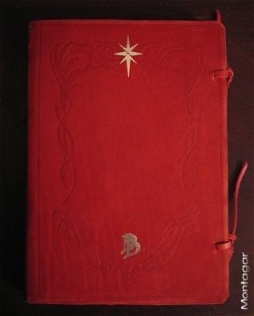 Can this be justified artistically? That is, quite apart from its narrative effectiveness, if we look at the book as a unity, does it make sense to meld the saga form with the matter of the land? Personally, I think there actually is a logic to it. Theoretically, The Lord of the Rings is, according to the prologue, “drawn mainly from the Red Book of Westmarch. … It was in origin Bilbo’s private diary, which he took with him to Rivendell. Frodo brought it back to the Shire, together with many loose leaves of notes, and during S.R. 1420–1 he nearly filled its pages with his account of the war.”
Can this be justified artistically? That is, quite apart from its narrative effectiveness, if we look at the book as a unity, does it make sense to meld the saga form with the matter of the land? Personally, I think there actually is a logic to it. Theoretically, The Lord of the Rings is, according to the prologue, “drawn mainly from the Red Book of Westmarch. … It was in origin Bilbo’s private diary, which he took with him to Rivendell. Frodo brought it back to the Shire, together with many loose leaves of notes, and during S.R. 1420–1 he nearly filled its pages with his account of the war.”
Tolkien goes on to describe the textual history of the Red Book, and how various copies had corrections or additions. I aim to explore the idea of the Red Book more next week, but for now I want to point out that Tolkien’s decided to frame his story as a translation of an older text. And that text was not written by humans, but by hobbits. One would logically expect, then, that the text would reflect the concerns of hobbits. And we know that hobbits were creatures of the land, possessing “a close friendship with the earth.”
So to me it only makes sense that a translation from a hobbit-written text would have a careful eye for the land. One of the few other hobbit books mentioned is a tome called Herblore of the Shire. Hobbits are related to humans, but not wholly human; it seems logical to me that they would produce a form of writing that would incorporate something of the structure of humans, but add detail about the natural world, and above all that they would compose great histories: “they liked to have books filled with things that they already knew, set out fair and square with no contradictions.” (And we’re told that at the end of the Third Age they developed “a more widespread interest in their own history; and many of their traditions, up to that time still mainly oral, were collected and written down. … By the end of the first century of the Fourth Age there were already to be found in the Shire several libraries that contained many historical books and records.”)
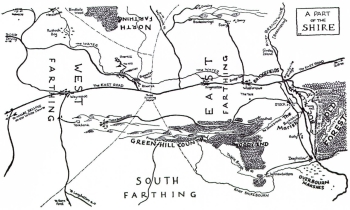 My point is that the style of the book can be seen to dovetail neatly with the overall structure. But more significant, I think, is the question: if it works, why does it work? How does all the detail about the land make the story better? You could say that it works just because it works; because as you read the book, the details feel right, and help to make the story more real. But I think there are a few other things to be said as well.
My point is that the style of the book can be seen to dovetail neatly with the overall structure. But more significant, I think, is the question: if it works, why does it work? How does all the detail about the land make the story better? You could say that it works just because it works; because as you read the book, the details feel right, and help to make the story more real. But I think there are a few other things to be said as well.
To start with, The Lord of the Rings is a great travel book. That relates, perhaps, to the fact that it’s an evocation of medieval literature; travel to far foreign places, and stories about the wonders to be found in other lands, was not uncommon in medieval writing. You can see a fascination with travel narratives and foreign parts in such things as the letters from Prester John or the supposed Travels of Sir John Mandeville.
I think that’s also something you get in The Lord of the Rings, where the process of travel is, for much of the cast, a journey into unknown lands. The hobbits don’t seem to know much geography past Bree, and even the maps at Rivendell don’t seem to speak to most of them. Aragorn knows his way around most places, but even he hasn’t been everywhere. It’s probably worth noting that the fantasy of the book, the sense of wonder following wonder, works in part because the characters are constantly journeying into lands most of them don’t know, and haven’t even heard anything about.
But my larger point here is that the book’s a description of a journey, and in order for that description to work, you need to describe the process of journeying. Tolkien’s got a sharp eye for the everyday chores and privations of an extended walking-trip — who does the cooking, and what it’s like trying to sleep on rocks or roots, and how uncomfortable a rain-storm can be. But more than that, for people travelling at a walking pace, the land through which they walk is the dominant fact around them. It’s what they see, and what they see changing; how they know they’re going from place to place. To describe that process is to put the readers firmly in the mindset of people taking a long voyage on foot.
 Sometimes that’s literally part of the point. Look at Chapter 6 of Book I, just before the hobbits encounter Old Man Willow. There’s a good page or two that begins “At length they made up their minds to go on again” and ends after five lengthy paragraphs when Merry says “Well, now I have at least some notion of where we are!” In terms of plot, you could delete almost all of those paragraphs, and replace them with something like: “The hobbits hoped to make their way north, but the forest seemed to direct them always in another direction; paths turned, folds of ground led them away to the south, and the trees always grew darker. At last they emerged to find the sun shining on a bright stream lined with willow trees.” But the book would be immeasurably poorer if you made that sort of edit.
Sometimes that’s literally part of the point. Look at Chapter 6 of Book I, just before the hobbits encounter Old Man Willow. There’s a good page or two that begins “At length they made up their minds to go on again” and ends after five lengthy paragraphs when Merry says “Well, now I have at least some notion of where we are!” In terms of plot, you could delete almost all of those paragraphs, and replace them with something like: “The hobbits hoped to make their way north, but the forest seemed to direct them always in another direction; paths turned, folds of ground led them away to the south, and the trees always grew darker. At last they emerged to find the sun shining on a bright stream lined with willow trees.” But the book would be immeasurably poorer if you made that sort of edit.
Read the full passage, and you walk with the hobbits (if only in spirit) as they try one direction and then another and are consistently directed elsewhere. Compress it, and you lose the character of the scene; you lose what’s really important in it in order to focus on plot. As a story-teller, Tolkien knows that there’s a difference between plot and story. And sometimes you want the plot to move more slowly so that the story can be more immersive and more powerful.
 But this example is extreme, I think. In fact, I think Tolkien’s less prone to extensive descriptions of this sort than is commonly held; but I think that his descriptions, even when they’re only a sentence or two, do stick in the mind — because they are vivid, and because they are frequent, and because they are important. I think they point to a number of themes in the book, and I think they do a lot more than is usually expected of landscape description.
But this example is extreme, I think. In fact, I think Tolkien’s less prone to extensive descriptions of this sort than is commonly held; but I think that his descriptions, even when they’re only a sentence or two, do stick in the mind — because they are vivid, and because they are frequent, and because they are important. I think they point to a number of themes in the book, and I think they do a lot more than is usually expected of landscape description.
Consider the way landscape, and reaction to landscape, becomes revelatory of character. In general you might expect that characters in a pre-industrial world would be more likely to respond to the land, to be alive to it, than a modern. I mentioned Gimli at the Glittering Caves last week; his reaction to the land is every bit as meaningful to his character, I feel, as his reaction to Galadriel. More, by having his reaction to both Galadriel and the Caves be one of a similar awe, I think Tolkien’s taking the awe we (likely) feel at Galadriel, and at the very least making it easy for us to transfer that sense of awe to the Caves — because we see that Gimli’s reacting in similar ways to both.
I also mentioned last week Legolas coming to Fangorn was a point of revelation about his character. Similarly, Aragorn, first coming into the lands of Gondor, in chapter 1 of Book III, spontaneously recites a poem about his kingdom. This is no minor thing; in the midst of a chase sequence, the book pauses for landscape and poetry. As a result we have a passage which, among other things, shows Aragorn’s desire to head south, and also his sense of duty which overrides that desire; his recollection of lore; the significance of his kingship; the symbols of Gondor; the richness of memory and history in that place; the linkage of tradition with land; and Aragorn’s grasp of those traditions, his own sense of the land. The plot pauses so that it can be given meaning.
The land brings out character. The land will tell you who a character is. And, of course, the land has a character itself. Obviously places like Mordor or Lothlórien are distinct one from another, and from, say, the Shire. But the Shire is also distinct from the land of Hollin. Rohan is not Gondor. All these places are distinct; they are different places that the tale goes, and they have different feels, different characters.
 Leaving Rivendell, the Fellowship encounter icy winds from the eastern mountains, tangled thorn-bushes, “bleak hills, and deep valleys filled with turbulent waters. Paths were few and winding, and led them often only to the edge of some sheer fall, or down into treacherous swamps.” Then, having travelled forty-five leagues (about 135 miles), they come to a new country, the land of Hollin, filled with holly-trees — a traditional symbol of rebirth in the depth of winter. “There is a wholesome air about Hollin,” says Gandalf. “Much evil must befall a country before it wholly forgets the Elves, if once they dwelt there.” But Legolas hears the stones mourning for the absence of the Elves, the land is vacant of animals, and the Fellowship seem to be spied on by sinister hawks and crebain. “Hollin is no longer wholesome for us,” concludes Aragorn.
Leaving Rivendell, the Fellowship encounter icy winds from the eastern mountains, tangled thorn-bushes, “bleak hills, and deep valleys filled with turbulent waters. Paths were few and winding, and led them often only to the edge of some sheer fall, or down into treacherous swamps.” Then, having travelled forty-five leagues (about 135 miles), they come to a new country, the land of Hollin, filled with holly-trees — a traditional symbol of rebirth in the depth of winter. “There is a wholesome air about Hollin,” says Gandalf. “Much evil must befall a country before it wholly forgets the Elves, if once they dwelt there.” But Legolas hears the stones mourning for the absence of the Elves, the land is vacant of animals, and the Fellowship seem to be spied on by sinister hawks and crebain. “Hollin is no longer wholesome for us,” concludes Aragorn.
With little actually happening in terms of plot, these pages expand the story tremendously. We get a sense of movement, of the journey from Rivendell through a hostile country to a place that is no longer a sanctuary. We get a sense of good things draining out of the land. We get a sense of rebrith being threatened, of the promise of the holly being undermined. The description of the land makes the story bigger, and more resonant.
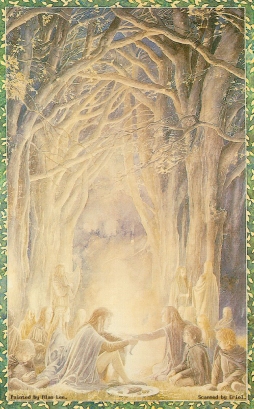 I think Tolkien has a real knack for finding resonance in place. Look at the Shire and the woods around it, which at first seem, if not a bucolic paradise, then at least a pleasant, unsurprising rural community. But then we find there are older and stranger things about. Obviously we see this in the Old Forest, but long before we get there Frodo tells the elf Gildor that “I knew that danger lay ahead, of course; but I did not expect to meet it in our own Shire,” and is told in response that “it is not your own Shire. Others dwelt here before hobbits were; and others will dwell here again when hobbits are no more.” The immediate point is that, as Gildor says, “The wide world is all about you: you can fence yourselves in, but you cannot for ever fence it out,” but it also has the effect of deepening the picture of the Shire, of hinting at a history the hobbits don’t understand.
I think Tolkien has a real knack for finding resonance in place. Look at the Shire and the woods around it, which at first seem, if not a bucolic paradise, then at least a pleasant, unsurprising rural community. But then we find there are older and stranger things about. Obviously we see this in the Old Forest, but long before we get there Frodo tells the elf Gildor that “I knew that danger lay ahead, of course; but I did not expect to meet it in our own Shire,” and is told in response that “it is not your own Shire. Others dwelt here before hobbits were; and others will dwell here again when hobbits are no more.” The immediate point is that, as Gildor says, “The wide world is all about you: you can fence yourselves in, but you cannot for ever fence it out,” but it also has the effect of deepening the picture of the Shire, of hinting at a history the hobbits don’t understand.
What I think is really remarkable in the book is the subtle manipulation of tone Tolkien can achieve with his landscape descriptions; different places have different feels. By careful attention to the details of the natural world, Tolkien is able to make his landscapes distinct, and make his world grander. In the Emyn Muil, for example, Frodo and Sam climb down a gully: “Some way down they found a few gnarled and stunted trees, the first they had seen for days: twisted birch for the most part, with here and there a fir-tree. Many were dead and gaunt, bitten to the core by eastern winds. Once in milder days there must have been a fair thicket in the ravine, but now, after some fifty yards, the trees came to an end, though old broken stumps straggled on almost to the cliff’s brink.” These are badlands; but once there was “a fair thicket,” even if now it’s hedged about with words like “gnarled and stunted,” “twisted,” “dead and gaunt.” These badlands are not Mordor. You can’t really imagine a fair thicket ever existing there, only, as Sam and Frodo find, thorn-bushes with long cruel needles.
But the thicket’s not there in the Emyn Muil any more; or at least it can no longer be called fair. The land is not static. And this is a fact that also shapes the book in several important ways.
To begin with, the seasons are important. The basic symbolism of the seasons is certainly present in the book, in which the characters struggle through winter and the dark lord is defeated in spring. Tolkien provides a detailed description of the passage of time, so that we always know where we are chronologically; an appendix even describes the variant calendars in use.
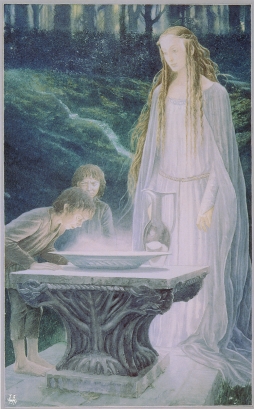 And if time and the seasons don’t pass everywhere, still in the long run they can’t be denied. Galadriel tells Sam that she gives him the gift of soil from Lórien that “you may remember Galadriel, and catch a glimpse far off of Lórien, that you have seen only in our winter. For our spring and our summer are gone by, and they will never be seen on earth again save in memory.” This is both symbolic and simply accurate; Lórien, which seems untouched by time, must fade with the ending of the Third Age. Men die and are reborn, like the years; the Elves seem untouched by time, but do not last forever, and in the end will be only a memory in Middle-earth.
And if time and the seasons don’t pass everywhere, still in the long run they can’t be denied. Galadriel tells Sam that she gives him the gift of soil from Lórien that “you may remember Galadriel, and catch a glimpse far off of Lórien, that you have seen only in our winter. For our spring and our summer are gone by, and they will never be seen on earth again save in memory.” This is both symbolic and simply accurate; Lórien, which seems untouched by time, must fade with the ending of the Third Age. Men die and are reborn, like the years; the Elves seem untouched by time, but do not last forever, and in the end will be only a memory in Middle-earth.
In fact, the gift-giving scene generally seems to be about memory. Galadriel begins by saying that the gifts are given “in memory of Lothlórien,” and ends by commanding Frodo “Remember Galadriel and her mirror!” Not long after, Frodo hears Galadriel for the last time singing in Elvish, and “as is the way of Elvish words, they remained graven in his memory” — while Legolas comforts Gimli, sad at leaving the woods, by telling him “the least reward that you shall have is that the memory of Lothlórien shall remain ever clear and unstained in your heart, and shall never fade nor grow stale.” But, says Gimli, “memory is not what the heart desires. That is only a mirror, be it clear as Kheled-zâram.” Which words again return us to Galadriel’s mirror.
Memory is important for Elves; but it’s important for the book as a whole. It’s a major theme (and so it’s appropriate that Tolkien describe in the prologue the way by which the tale is remembered and recorded). Part of the story’s distinctive colouring comes from the way events are shaped by distant memory, by a history half-glimpsed. We learn this history in song and legends; by the memory of the poet and tale-teller. And by other means as well. We learn history by seeing the memory of it embodied in the land; by hearing stones lamenting the Elves that have gone. By hearing Aragorn’s ancestral kingdom speak to him, telling him where the Orcs that captured Merry and Pippin have gone.
The land fuses history and geography. Barrows, near the Shire and even more in Rohan, unite the men of the past with the earth. When Gandalf Aragorn, Gimli, and Legolas come to Rohan and see the barrows, they talk about the history of the land; for Legolas only “a little while” has passed since the Rohirrim came to their land, but Aragorn tells him that for the Riders “the raising of this house is but a memory of song.” And then again Aragorn sings of the times past. The physical world is shaped by the past, by the men of the past; and it slips into poetry, into words. Another way to look at it is to say that mortal men can join with the land — but only in death. On the one hand, that’s an appropriate example of Tolkien’s tragic sensibility. On the other hand, it’s also a contrast with the nature of Elven memory. For Men, the land becomes memory.
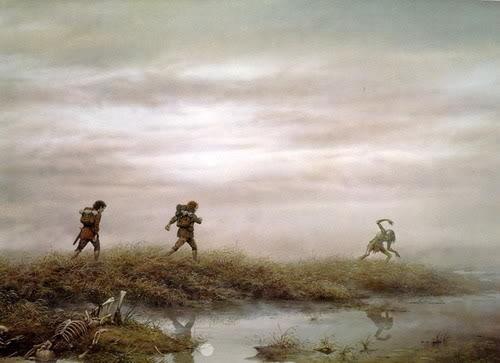 But Men and Elves come together in the Dead Marshes, which are a permanent monument to the Last Alliance. To me it seems also that they’ve become a sign of what Sauron will do to everyone, everywhere. The land, the way Tolkien describes the land, creates a sense of the past and the presence of the past, but also can be seen as a foreshadowing, as a warning. It’s notable that the Marshes come right after Frodo explicitly accepts, and tells Sam, that they won’t be coming back from Mordor; the land reflects the emotional tenor of that part of the story.
But Men and Elves come together in the Dead Marshes, which are a permanent monument to the Last Alliance. To me it seems also that they’ve become a sign of what Sauron will do to everyone, everywhere. The land, the way Tolkien describes the land, creates a sense of the past and the presence of the past, but also can be seen as a foreshadowing, as a warning. It’s notable that the Marshes come right after Frodo explicitly accepts, and tells Sam, that they won’t be coming back from Mordor; the land reflects the emotional tenor of that part of the story.
Another way to look at the Marshes, though, is to say that they demonstrate the way the land can carry a spiritual value. You can see it also in Hollin, which has not toally forgotten the elves, as well obviously in Rivendell and Lórien, and, in a negative sense, in Mordor. I don’t just mean that Rivendell is lush and beautiful while Mordor is barren and blasted; I mean that the inhabitants and the land are linked, by history and a more profound spiritual tie. Look at Minas Tirith, where a hill (albeit a hill that has been worked over by the hands of men) drives like the keel of a ship into the heart of the city; the earth physically penetrates even the most urban part of the story.
Or consider the scene in which Gandalf reawakens Théoden to his true potency. He does it by leading Théoden to the doors of his hall and having him look out over his land:
“Now, lord,” said Gandalf, “look out upon your land! Breathe the free air again!”
From the porch upon the top of the high terrace they could see beyond the stream the green fields of Rohan fading into distant grey. Curtains of wind-blown rain were slanting down. The sky above and to the west was still dark with thunder, and lightning far away flickered among the tops of hidden hills. But the wind had shifted to the north, and already the storm that had come out of the East was receding, rolling away southward to the sea. Suddenly through a rent in the clouds behind them a shaft of sun stabbed down. The falling showers gleamed like silver, and far away the river glimmered like a shimmering glass.
“It is not so dark here,” said Théoden.
The scene insists upon the traditional tie between the king and the land. Théoden’s a kind of fisher king; but instead of being revived by a wandering knight, which thus brings about the revival of the land, it is the land itself which serves to revive him. The land and the people are one. Before Théoden looks out on his realm, he is confused, fearful, and you wonder if he’s just latched on to Gandalf as a substitute for Gríma; after, he’s stern and kingly. In many ways Théoden here is an anti-Lear; not an outcast on a blasted heath mocked by a violent and uncaring storm that echoes his own madness, but a king in his hall who sees a storm pass.
(The movie, of course, staged this scene very differently. Visually sumptuous as the films are, I think they may be most useful as a guide to what is strangest in the books, what is most characteristic; that is what was cut, what had to have conventional naturalistic drama superimposed over it. That might explain the way they handled The Two Towers, especially the scenes with Theoden, who has literally become an entirely different character. In the book I think he’s much more an archetypal king, just as the whole incident with the expulsion of Gríma has an archetypal feel to it — even Théoden’s name is an Old English word meaning literally “lord” or “king.” That ability to play with words, traditions, and common images is I think distinctively Tolkienian.)
 So the descriptions of the land, in the end, are descriptions of states of mind, of states of spirit, reflections of the emotions of the story at that moment. The tone we find in the land helps to focus our reaction to the tale being told. There’s an odd parallel to be made here with early gothic literature, with something like Ann Radcliffe’s The Romance of the Forest, which is filled with detailed landscapes and which engages with Enlightenment ideas of beauty and the sublime. Like The Lord of the Rings, it also contains a number of poems, and tries to revive an earlier period of history.
So the descriptions of the land, in the end, are descriptions of states of mind, of states of spirit, reflections of the emotions of the story at that moment. The tone we find in the land helps to focus our reaction to the tale being told. There’s an odd parallel to be made here with early gothic literature, with something like Ann Radcliffe’s The Romance of the Forest, which is filled with detailed landscapes and which engages with Enlightenment ideas of beauty and the sublime. Like The Lord of the Rings, it also contains a number of poems, and tries to revive an earlier period of history.
But Tolkien was not a Romantic in the traditional literary sense, and he was not writing a Gothic story. His landscapes aren’t in that tradition of the sublime. His landscapes aren’t symbols of something greater beyond themselves, except insofar as everything in the world can be read as a symbol of some greater truth. He isn’t writing a symbolist work. He isn’t imagining a mountain or a river as an image of some unknowable creative process; the mountain and the river are the mountain and the river. They’re parts of a story, and I think Tolkien knew that as such they work best when most real.
 Tolkien’s own sense of the land is almost startling, at times. When he has Treebeard make the casual but entirely accurate observation that ‘hill’ is “a hasty word for a thing that has stood here ever since this part of the world was shaped,” we suddenly seem to see not only the hill itself as a different thing, but also become conscious of the word ‘hill’ in a way that we weren’t before.
Tolkien’s own sense of the land is almost startling, at times. When he has Treebeard make the casual but entirely accurate observation that ‘hill’ is “a hasty word for a thing that has stood here ever since this part of the world was shaped,” we suddenly seem to see not only the hill itself as a different thing, but also become conscious of the word ‘hill’ in a way that we weren’t before.
So fully realised is the world and its geography that the maps really aren’t necessary. You can follow the action quite easily from the text alone. It’s something that’s easy to overlook, given how much of a staple in fantasy fiction maps have become; but the world as Tolkien wrote it is complete in itself.
I think the intensive detailing and description of that world was necessary. I think it enriches the story. I think Tolkien uses it to heighten the tones of the tale, to bring out character, and to bring out the themes that fascinated him. And I think it serves also to highlight what is important in the book; what is at risk. The world is not simply beautiful, nor is it merely sublime. It is a living thing, that has a history and a character of its own. Middle-earth is the key to the story of The Lord of the Rings; it’s only fitting that the story illuminate it, and that we come to feel the land just as the characters do.
Matthew David Surridge is the author of “The Word of Azrael,” from Black Gate 14. His blog is Hochelaga Depicta.
The Lord Of The Rings has always been a milieu story. Tolkien is just as fascinated by his world as his characters and plot. And the story is of a WORLD not those characters and events. People who criticize his long descriptions don’t know storytelling, I think, or have failed to recognize milieu stories as a legitimate mode of storytelling.
A very thoughtful post. I thoroughly enjoy Tolkien’s use of landscapes although they, like many other aspects of his work, leave me with a sense of melancholy. Tolkien recognized that land and people are tied together in an organic manner – a noble concept distorted in various ways by nationalism and the ideologies (Right and Left) of the 20th Century. Tolkien’s landscapes are appealing because they remind us that things weren’t always the way they are today and that we should honor our land, our history, and our forefathers.
It’s nice to see an article about The Lord of the Rings. One interesting topic that Matthew doesn’t raise here is how Tolkien’s descriptions of the physical reality of Middle-earth aren’t matched by descriptions of its inhabitants. He usually gives emotional rather than physical descriptions of his characters. And the stranger the characters, like the orcs or the Balrog, the fewer clues Tolkien gives to their appearances. The Balrog is terrifying because the emotional impression given creates a sense of horror beyond description. Yet this indescribable character lives in a precisely-described world.
Bryan: Yes! Absolutely the story’s about the world. And I agree that the use of description is a characteristic of the storytelling, and a valuable approach to writing.
Tyr: Thanks! I too feel the melancholy in Tolkien’s landscapes. I suspect the book was written in part as a response to changes in the landscape around Tolkien, a process of change that’s only accelerated in recent years.
Jeremy: That’s a great point about the discrepancy in descriptions. Actually (and this is a weird connection), it reminds me of Scott McCloud’s argument about how comics, especially Japanese comics, worked: a hyper-detailed background, with a more cartoony-looking main character. McCloud argued that the lack of specificity allowed readers to project themselves into the character as a result, creating a greater sense of reader identification. Tolkien’s doing something different in the case of the Balrog; as you point out, it’s more a kind of impressionism. But it does seem to work.